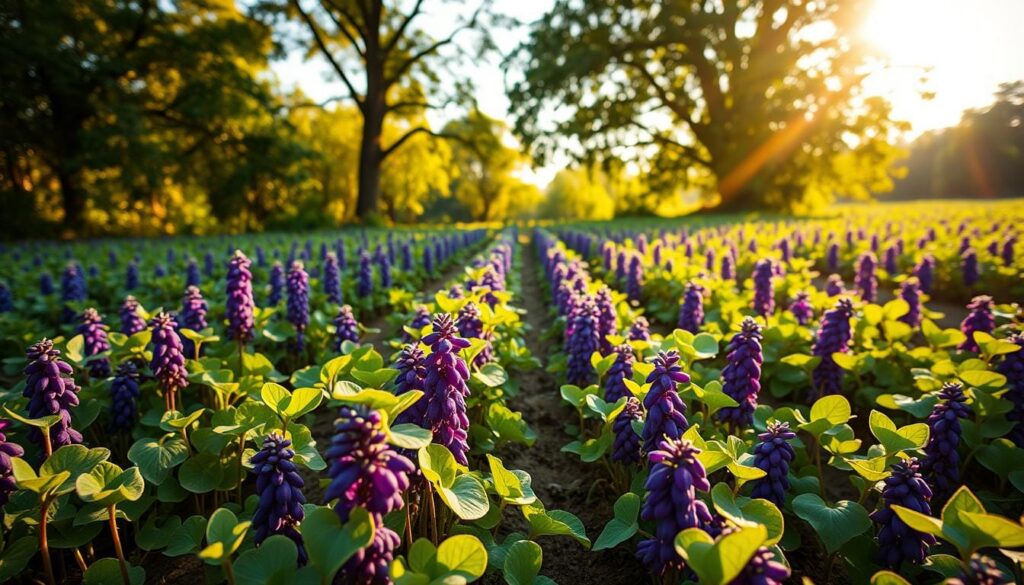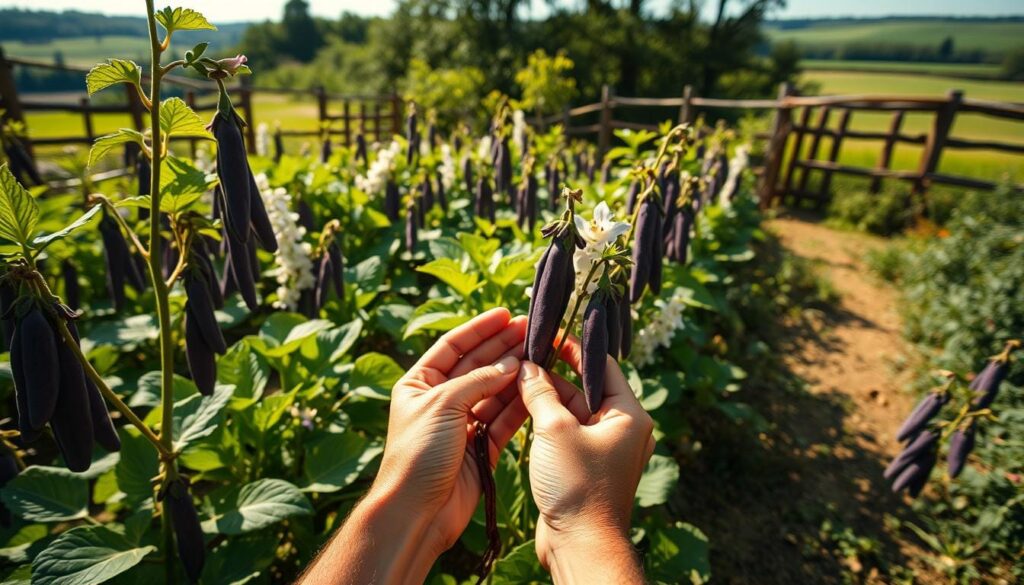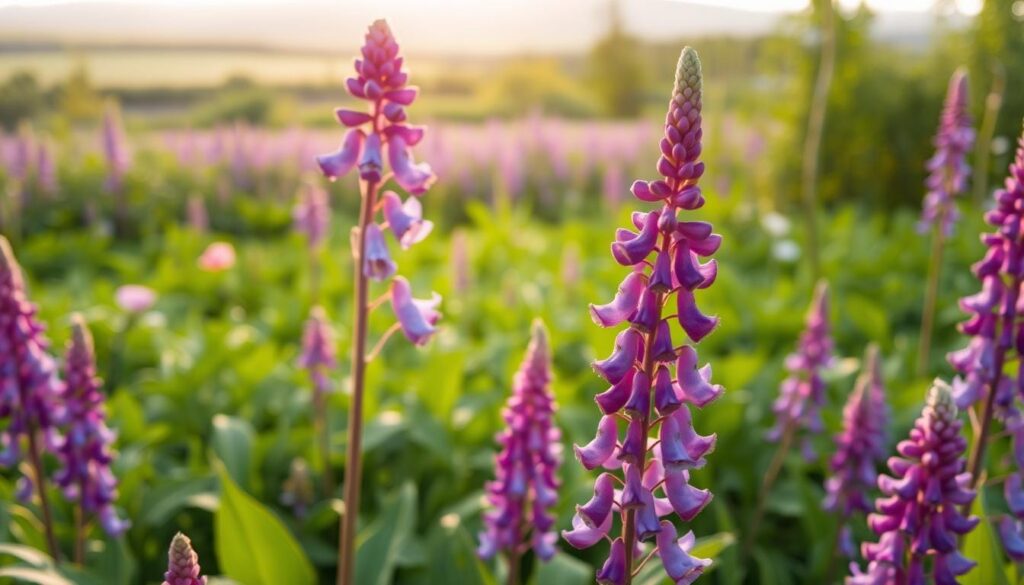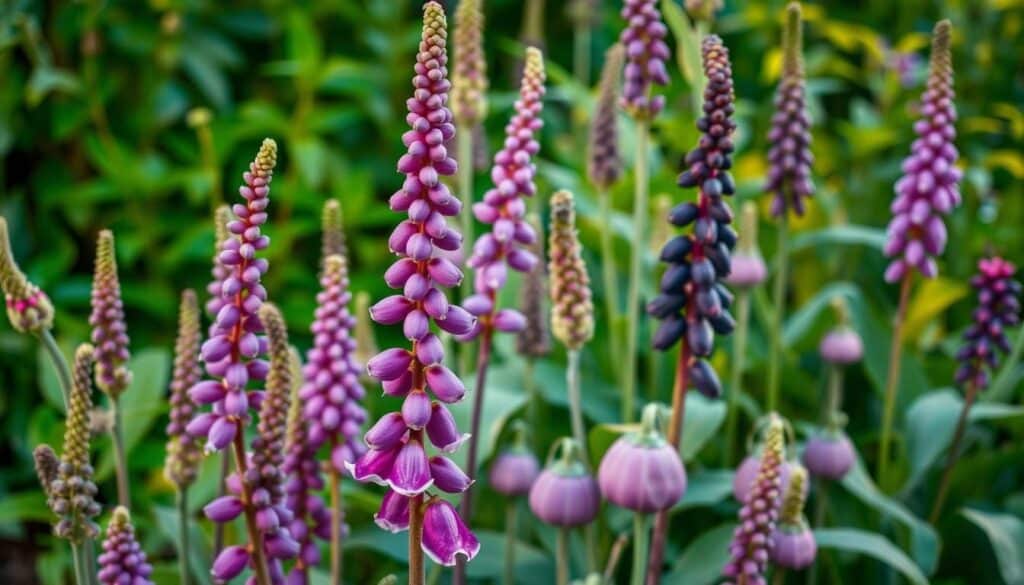Imagine a plant that turns your garden into a canvas of violet flowers and feeds your family. The hyacinth bean, known as Lablab purpureus, is this rare gem. It’s not just a beauty with its heart-shaped leaves and vines. Its purple pods and seeds also provide nutrition, making it a favorite in gardens and kitchens everywhere.
If you love gardening or cooking, the hyacinth bean is for you. It’s a versatile edible legume that grows well in many places. From sunny Southern states to tropical areas, it thrives. Its roots connect us to global traditions, from Indian curries to African stews, showing its lasting value.
Key Takeaways
- The hyacinth bean combines ornamental appeal and edible uses, making it a dual-purpose plant.
- Scientifically named Lablab purpureus, it grows rapidly and adapts to various climates.
- Its pods and seeds are rich in protein, fitting into both modern and traditional dishes.
- It supports sustainable gardening by enriching soil and attracting pollinators.
- Cultures around the globe have relied on it for centuries, blending nutrition and biodiversity.
What is the Hyacinth Bean?
The hyacinth bean, known scientifically as Lablab purpureus, is a colorful legume. It’s loved for its bright look and ability to grow in many places. Originally from the tropics, it has traveled the world through trade and farming.
Botanical Classification
Lablab purpureus belongs to the Leguminosae family, like peas and beans. Its name has changed over time, once called Dolichos lablab. This name shows its place in botany and its role in fixing nitrogen in the environment.
Common Names and Variants
The purple hyacinth bean is known by many names. In Southeast Asia, it’s called seim, and in India, it’s known as madras bean. There are different types, including:
- Purple hyacinth bean: Known for its deep violet flowers and pods
- White-flowered types: Have cream-colored blooms and green pods
- Japanese purple vine: A favorite for gardens
Its vines and flowers add beauty to gardens. The pods can be eaten when young or dried for later use. This shows how well it adapts to different places.
Nutritional Profile of Hyacinth Beans
Hyacinth beans, also known as Lablab purpureus, are a great source of nutrients. They are a key edible legume in plant-based diets. These beans support overall health.
Vitamins and Minerals
Hyacinth beans are packed with B vitamins, like folate, which boosts energy. They also have iron for carrying oxygen and magnesium for nerves. Plus, they have potassium and zinc for extra health benefits. Here’s a quick look:
- Folate: 30% of daily needs per 100g serving
- Iron: 20% of daily recommended intake
- Magnesium: Supports bone and heart health
Protein Content
Hyacinth beans are a complete protein, meaning they have all nine essential amino acids. This is rare among legumes. Let’s compare their amino acids to soybeans:
| Amino Acid | Hyacinth Bean | Soybean |
|---|---|---|
| Lysine | High | High |
| Methionine | Sufficient | Low |
| Threonine | Abundant | Abundant |
Soaking and cooking hyacinth beans right, like in harvest planning guides, unlocks their nutrients. Their protein is as good as animal proteins, making them a green choice for food.
Growing Conditions for Hyacinth Beans
Learning about the hyacinth bean‘s needs is key. It loves certain climates and soils. With the right growing tips, gardeners in many places can grow this beautiful ornamental vine.
Ideal Climate
Hyacinth beans do best in warm weather. They need:
- Temperature: Best when it’s 65–85°F (18–29°C) during the day.
- Light: They love full sun (6+ hours a day). But, they can handle some shade in very hot places.
- Zones: They’re perennials in USDA zones 9–11. In colder zones (3–8), grow them as annuals and protect them from winter.
- Humidity: They like moderate humidity. But, they need good air flow to avoid mildew.
For tips on planting in your zone, check out The Spruce.
Soil Requirements
Soil quality is very important. They need:
- pH: A pH of 6.0–7.0 (slightly acidic to neutral).
- Texture: They prefer loamy soil that drains well. Adding compost can help the soil.
- Fertility: Feed them regularly with balanced fertilizer. This helps with flowers and beans.
Keep the soil moist but not too wet to prevent root rot. Mulch around the plants to keep moisture in and weeds out.
Planting Hyacinth Beans
Learning the basics of planting is key for a healthy vine. Follow these steps to keep up with gardening trends and increase your chances of success.
Seed Selection
Opt for plump, unblemished seeds for better germination. Heirloom varieties like Lablab purpureus are great. You can also find local options that fit your climate. Soaking seeds overnight or nicking them with a nail file can help them sprout faster.
Sowing Techniques
Plant seeds 1-2 inches deep in well-drained soil when frost risks are gone. For hyacinth bean vines, direct sowing is best in USDA zones 8-11. In colder areas, use biodegradable pots and transplant seedlings after the last frost.

Optimal Spacing
Space plants 6-12 inches apart for good airflow. Train vines on trellises or fences to save space—a popular gardening trend for small gardens. Planting with marigolds or corn can also help deter pests and use space wisely.
- Rows spaced 3-6 feet apart for full canopy development
- Vertical structures boost yields while reducing disease risks
- Companion planting with legumes enriches soil nitrogen
These growing tips can make anyone a gardening pro, whether you’re growing for looks or food.
Care and Maintenance
To keep your hyacinth bean plants healthy, focus on watering, pest control, and nutrients. This care guide helps your ornamental vine grow well and produce lots of beans. Follow these growing tips to help it grow from seed to harvest.
Watering Guidelines
Change how often you water based on the plant’s growth and the weather. New seeds need water often until they grow, while big plants need deep water once a week. Mulch helps keep the soil moist and stops weeds. But don’t water too much, as it can harm the roots in clay soils.
- Water in the morning to cut down on evaporation.
- Don’t water as much when it rains to avoid too much water.
“Mulch acts as a natural shield against moisture loss and temperature extremes.”
Pest Control Methods
Watch out for aphids, spider mites, and diseases. Check the leaves often for any signs of pests:
| Pest/Disease | Symptoms | Solution |
|---|---|---|
| Aphids | Curling leaves, sticky residue | Introduce ladybugs or spray with insecticidal soap. |
| Powdery Mildew | White powdery coating on foliage | Prune affected leaves and apply sulfur-based fungicide. |
Use neem oil sprays every two weeks to prevent pests. Change what you grow every year to keep pests away.
Test the soil often to make sure it has enough nitrogen and phosphorus. Use a balanced fertilizer every month when the plant is growing. This keeps the ornamental vine looking good and producing lots of beans.
Harvesting Hyacinth Beans
Timing is key when picking hyacinth bean crops. Harvesting right ensures the best taste and health benefits. Follow these steps to get the most from your harvest and keep your plants healthy.

Signs of Maturity
- Young beans: Pick tender pods 2–3 inches long for stir-fries. They’ll feel like snap beans.
- Shelling stage: Wait until pods swell but are slightly flexible. Seeds inside should rattle softly.
- Seed saving: Leave pods on vines until they turn brown and crisp. Harvest before wind scatters dried beans.
Harvesting Techniques
Use sharp scissors or gloves to grip stems firmly. Cut pods at a 45-degree angle to avoid damaging stems. For seed saving, store dried beans in a cool, dry place in paper bags. Commercial growers often use mesh sacks for airflow.
Check plants weekly during peak season. Frequent harvesting encourages new growth. Wilted pods signal missed timing—act before they harden. Proper handling preserves the plant’s energy for future yields.
Culinary Uses of Hyacinth Beans
Hyacinth beans are a versatile edible legume. They can be used in many ways in cooking. But, it’s important to cook them well to make them safe to eat. The tender pods and dried seeds are great in many dishes, adding nutrition to your meals.
Cooking Methods
Learn how to cook hyacinth beans to bring out their flavor:
- Boil mature beans 2–3 hours until tender. Soak overnight first.
- Stir-fry young pods briefly to retain crispness.
- Simmer dried beans in soups or stews for enhanced texture.
Popular Recipes
Discover dishes from around the world that use hyacinth beans:
| Recipe Name | Cuisine | Key Ingredients | Method |
|---|---|---|---|
| Thai Green Curry | Thai | Young pods, coconut milk, chili | Sauté aromatics, add beans and simmer in curry. |
| Indian Dal | Indian | Dried beans, cumin, tomatoes | Pressure-cook beans, blend with spices. |
| African Stew | African | Pods, yams, tomatoes | Slow-cook with vegetables and broth. |
Nutritional Benefits in Dishes
How you cook hyacinth beans affects their nutrients. Boiling keeps minerals, while dry heat increases fiber. Serve them with leafy greens or whole grains for a balanced meal. Here are some good pairings:
- Beans + quinoa for complete protein
- Pods + spinach for iron absorption
These recipes show how hyacinth beans can make dishes better. They add protein and antioxidants.
Cultural Significance Across Regions

The hyacinth bean is a key part of many cultures around the world. In Asian cuisines, it’s a star ingredient in many dishes. In India, it’s used in curries and stir-fries. In Thailand, it’s fermented to add flavor.
In Vietnam, its seeds are pickled, and in China, its flowers are used in soups. These dishes are more than just food; they connect people to their heritage.
- India: Hyacinth bean curries with coconut milk
- Thailand: Stir-fried shoots with chili and garlic
- China: Blossom soups symbolizing prosperity
Hyacinth Beans in Asian Cuisine
In Japan, the bean’s purple seeds are used in festive desserts like mochi. In Southeast Asia, its leaves are used in traditional medicine. This shows how the bean combines nutrition and healing.
Africa’s Traditional Usage
In East Africa, the hyacinth bean is a key crop that grows well in dry conditions. In Kenya, people dry the seeds to store for later. This helps ensure they always have food.
In Tanzania, farmers grow it alongside maize to improve the soil. This practice has been passed down for generations. Swahili traders also used the bean in their coastal trade routes.
“The hyacinth bean is more than food—it’s a bridge between past and present.” — African agricultural historian Amina Njeri
The journey of the hyacinth bean shows human strength and adaptability. It’s a symbol of culture and a valuable food source worldwide.
Hyacinth Beans in Sustainable Gardening
Hyacinth bean is a key player in gardening trends for its two roles. It’s an ornamental vine and a natural soil enhancer. These plants love sunny spots and make the soil better while looking great. Discover how to use their natural advantages.
Soil Enrichment Benefits
Hyacinth bean is a legume that works with Rhizobium bacteria. This team turns air nitrogen into soil nutrients. They add up to 150 pounds of nitrogen per acre each year. To get the most benefits, follow growing tips and use green manuring to recycle nutrients.
- Plant in well-drained soil for optimal nutrient uptake
- Rotate with non-legume crops every 2-3 years
Companion Planting Strategies
Pair hyacinth bean with plants that need nutrient-rich soil:
| Partner Plant | Benefit |
|---|---|
| Corn | Hyacinth bean’s vines climb stalks, reducing weeds |
| Squash | Shade from leaves suppresses weed growth |
| Avoid | Tomatoes and alliums due to root competition |
Use these tips in gardening trends like regenerative agriculture. Hyacinth bean’s two roles make it essential for eco-friendly gardens.
Hyacinth Beans and Their Role in Biodiversity
The purple hyacinth bean is more than a pretty vine. It’s a key player in healthy ecosystems. Its vibrant purple flowers and strong growth make it a highlight in gardens. It also helps bring more life to the environment.

Attracting Pollinators
This plant’s flowers are like a signpost for pollinators. They welcome:
- Bumblebees and honeybees to its sweet nectar.
- Butterflies and hummingbirds to its long, purple flowers.
- They visit most during the day when the sun makes nectar flow. This helps fill a food gap in late summer.
Supporting Ecosystems
The vine does more than just attract pollinators. It also helps ecosystems in three important ways:
- Shelter for Beneficial Insects: Its thick leaves protect ladybugs and wasps.
- Soil Health: When leaves fall, they turn into rich mulch. This makes the soil better for plants.
- Modern Garden Trends: It fits with green gardening ideas like saving pollinators and welcoming wildlife.
The purple hyacinth bean shows how vines can be both beautiful and useful. It’s a great pick for gardens that want to help local animals and follow the latest gardening trends.
Health Benefits of Hyacinth Beans
The hyacinth bean, or Lablab purpureus, is a special edible legume. It’s packed with nutrients that can boost your health. But, it’s important to handle it carefully.
Antioxidant Properties
- Hyacinth beans have polyphenols and flavonoids that fight oxidative stress.
- They are rich in vitamins C and E, which can reduce inflammation and lower disease risks.
- Research shows these antioxidants help the heart and immune system.
Possible Health Risks
Hyacinth beans have natural defenses:
- Raw beans contain cyanogenic glycosides that turn into toxins if not cooked.
- Lectins in undercooked beans can cause stomach problems.
- Allergic reactions are possible; talk to a doctor if you have symptoms.
Cooking hyacinth beans thoroughly removes risks. Always boil them until they’re fully cooked.
Hyacinth Bean Varieties to Explore
Hyacinth beans come in a wide range of colors and uses. They can be beautiful vines or tasty vegetables.  The best one for you depends on what you want. They are popular everywhere for their looks and usefulness.
The best one for you depends on what you want. They are popular everywhere for their looks and usefulness.
Explore these standout options:
Popular Varieties in the U.S.
- Ruby Moon: A favorite ornamental vine known for deep purple leaves and striking flowers. Thrives in USDA zones 5–9, perfect for trellises or arbors.
- White Moon: Features silvery foliage and pale blooms, contrasting well with greenery. Ideal for northern climates.
- Standard purple hyacinth bean: The classic choice for both ornamental and edible pods. Adapts to most regions with full sun.
Unique Cultivars
There are also unique types like ‘Long Pod’ and ‘Purple Butterfly.’ ‘Thai Dragon’ has twisted leaves. For telling purple blooms from weeds, check this guide.
Think about how much space you have and what you want most. Many places sell these varieties, making them easy to find for your garden.
Hybrid Hyacinth Beans
Modern gardening trends show hybrid hyacinth beans as a favorite. They mix traits from two parents for better performance. This results in stronger growth and more yields than traditional types.
Advantages of Hybrids
Hybrid plants offer special benefits. Key advantages include:
- Disease resistance to common pests and fungi.
- Climate adaptability for diverse growing zones.
- Custom traits like compact growth for small-space gardening.
Growing Hybrid Varieties
Here are some growing tips for the best results:
- Plant in fertile soil with consistent moisture.
- Space plants 12–18 inches apart to prevent overcrowding.
- Use supports like trellises to guide vining stems.
Hybrid seeds won’t reproduce true to type, so buy new seeds yearly. Many gardeners like hybrids for their reliability. But some prefer heirlooms for seed saving. Try both to see what works best for you.
Common Myths About Hyacinth Beans
Many gardeners stay away from hyacinth beans because of myths. These myths hide the benefits of this edible legume. Let’s clear up the facts so you can enjoy growing it safely.
Debunking Misconceptions
- Myth 1: “All parts are toxic.”
Fact: Only raw seeds and pods have cyanogenic glycosides. These break down when cooked. - Myth 2: “Purple hyacinth bean varieties are inedible.”
Fact: The ornamental types like ‘Lablab purpureus’ are safe if cooked right. - Myth 3: “Hyacinth beans are invasive everywhere.”
Fact: They grow fast but aren’t invasive everywhere. Check local rules for your area.
Understanding Toxicity Risks
Raw hyacinth beans have cyanogenic glycosides. But cooking them makes them safe. Here’s how to do it:
- Soak seeds overnight to cut down on toxins.
- Boil them for 10–15 minutes before using.
- Don’t eat unripe pods or sprouted seeds.
Always check a care guide for safe handling tips. Leaves and flowers are safe if treated right.
Conclusion: Embracing the Hyacinth Bean
Hyacinth bean is a plant that brings beauty and usefulness together. It fits well into today’s gardening trends. It serves as both an ornamental vine and a source of nutrients, making it a great choice for gardeners.
Final Thoughts on Cultivation and Use
For successful growth, warm climates and well-drained soil are key. Proper spacing and regular care help vines thrive. They produce beautiful blooms and tasty pods.
Harvesting at the right time boosts flavor and nutrition. This aligns with the growing interest in eating food grown at home. These beans are a rewarding addition to any garden in the U.S.
Hyacinth Bean in Sustainable Landscaping
Today, gardens focus on plants that look good and help the environment. Hyacinth bean’s purple vines are perfect for adding color to vertical gardens or trellises. They also improve soil by fixing nitrogen, reducing the need for synthetic fertilizers.
They are great for small urban gardens because they grow well in tight spaces. They combine beauty with usefulness, making them a smart choice for gardeners.

